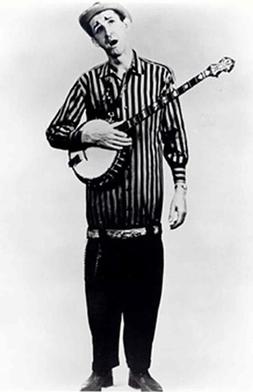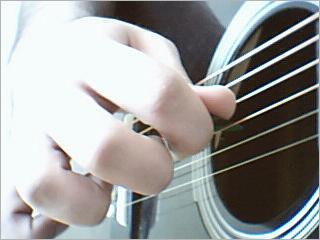The banjo is a stringed instrument with a thin membrane stretched over a frame or cavity to form a resonator. The membrane is typically circular, in modern forms usually made of plastic, originally of animal skin. Early forms of the instrument were fashioned by African Americans and had African antecedents. In the 19th century, interest in the instrument was spread across the United States and United Kingdom by traveling shows of the 19th century minstrel show fad, followed by mass-production and mail-order sales, including instruction method books. The inexpensive or home-made banjo remained part of rural folk culture, but 5-string and 4-string banjos also became popular for home parlour music entertainment, college music clubs, and early 20th century jazz bands. By the early 21st century, the banjo was most frequently associated with folk, bluegrass and country music, but was also used in some rock, pop and even hip-hop music. Among rock bands, the Eagles, Led Zeppelin, and the Grateful Dead have used the five-string banjo in some of their songs.

Bluegrass music is a genre of American roots music that developed in the 1940s in the Appalachian region of the United States. The genre derives its name from the band Bill Monroe and the Blue Grass Boys. Like mainstream country music, it largely developed out of old-time string music, though in contrast, bluegrass is traditionally played exclusively on acoustic instruments and also has roots in traditional English, Scottish, and Irish ballads and dance tunes as well as in blues and jazz. Bluegrass was further developed by musicians who played with Monroe, including 5-string banjo player Earl Scruggs and guitarist Lester Flatt. Monroe characterized the genre as, "Scottish bagpipes and ole-time fiddlin'. It's a part of Methodist, Holiness and Baptist traditions. It's blues and jazz, and it has a high lonesome sound."

Scruggs style is the most common style of playing the banjo in bluegrass music. It is a fingerpicking method, also known as three-finger style. It is named after Earl Scruggs, whose innovative approach and technical mastery of the instrument have influenced generations of bluegrass banjoists ever since he was first recorded in 1946. It contrasts with earlier styles such as minstrel, classic, or parlor style, clawhammer/frailing/two-finger style, jazz styles played with a plectrum, and more modern styles such as Keith/melodic/chromatic/arpa style and single-string/Reno style. The influence of Scruggs is so pervasive that even bluegrass players such as Bill Keith and Don Reno, who are credited with developing these latter styles, typically work out of the Scruggs style much of the time.

The hurdy-gurdy is a string instrument that produces sound by a hand-crank-turned, rosined wheel rubbing against the strings. The wheel functions much like a violin bow, and single notes played on the instrument sound similar to those of a violin. Melodies are played on a keyboard that presses tangents—small wedges, typically made of wood or metal—against one or more of the strings to change their pitch. Like most other acoustic stringed instruments, it has a sound board and hollow cavity to make the vibration of the strings audible.

Clawhammer, sometimes called down-picking, overhand, or frailing, is a distinctive banjo playing style and a common component of American old-time music.

Old-time music is a genre of North American folk music. It developed along with various North American folk dances, such as square dancing, clogging, and buck dancing. It is played on acoustic instruments, generally centering on a combination of fiddle and plucked string instruments, most often the banjo, guitar, and mandolin. The genre is considered a precursor to modern country music.

The Appalachian dulcimer is a fretted string instrument of the zither family, typically with three or four strings, originally played in the Appalachian region of the United States. The body extends the length of the fingerboard, and its fretting is generally diatonic.
In music, a drone is a harmonic or monophonic effect or accompaniment where a note or chord is continuously sounded throughout most or all of a piece. A drone may also be any part of a musical instrument used to produce this effect; an archaic term for this is burden such as a "drone [pipe] of a bagpipe", the pedal point in an organ, or the lowest course of a lute. Α burden is also part of a song that is repeated at the end of each stanza, such as the chorus or refrain.

Fingerstyle guitar is the technique of playing the guitar or bass guitar by plucking the strings directly with the fingertips, fingernails, or picks attached to fingers, as opposed to flatpicking. The term "fingerstyle" is something of a misnomer, since it is present in several different genres and styles of music—but mostly, because it involves a completely different technique, not just a "style" of playing, especially for the guitarist's picking/plucking hand. The term is often used synonymously with fingerpicking except in classical guitar circles, although fingerpicking can also refer to a specific tradition of folk, blues and country guitar playing in the US. The terms "fingerstyle" and "fingerpicking" are also applied to similar string instruments such as the banjo.

David Akeman better known as Stringbean, was an American singer-songwriter, musician, comedian, and semiprofessional baseball player best known for his role as a main cast member on the hit television show Hee Haw and as a member of the Grand Ole Opry. Akeman was well known for his "old-fashioned" banjo-picking style, careful mix of comedy and music, and his memorable stage wardrobe. Akeman and his wife were shot and murdered by burglars in their rural Tennessee home near Ridgetop in 1973.

Appalachian music is the music of the region of Appalachia in the Eastern United States. Traditional Appalachian music is derived from various influences, including the ballads, hymns and fiddle music of the British Isles, the African music and blues of early African Americans, and to a lesser extent the music of Continental Europe.
A string band is an old-time music or jazz ensemble made up mainly or solely of string instruments. String bands were popular in the 1920s and 1930s, and are among the forerunners of modern country music and bluegrass. While being active countrywide, in Philadelphia and its surrounding suburbs they are a huge part of its musical culture and traditions, appearing, among others, in the yearly Mummers Parade.

Flatpicking is the technique of striking the strings of a guitar with a pick held between the thumb and one or two fingers. It can be contrasted to fingerstyle guitar, which is playing with individual fingers, with or without wearing fingerpicks. While the use of a plectrum is common in many musical traditions, the exact term "flatpicking" is most commonly associated with Appalachian music of the American southeastern highlands, especially bluegrass music, where string bands often feature musicians playing a variety of styles, both fingerpicking and flatpicking. Musicians who use a flat pick in other genres such as rock and jazz are not commonly described as flatpickers or even plectrum guitarists. As the use of a pick in those traditions is commonplace, generally only guitarists who play without a pick are noted by the term "fingerpicking" or "fingerstyle".

The akonting is the folk lute of the Jola people, found in Senegal, Gambia, and Guinea-Bissau in West Africa. It is a banjo-like instrument with a skin-headed gourd body, two long melody strings, and one short drone string, akin to the short fifth "thumb string" on the five-string banjo.

Irish traditional music is a genre of folk music that developed in Ireland.

Carter Family picking, also known as the thumb brush, the Carter lick, the church lick, or the Carter scratch, is a style of fingerstyle guitar named after Maybelle Carter of the Carter Family. It is a distinctive style of rhythm guitar in which the melody is played on the bass strings, usually low E, A, and D while rhythm strumming continues above, on the treble strings, G, B, and high E. This often occurs during the break. The style bears similarity to the frailing style of banjo playing and is the rhythm Bill Monroe adapted for bluegrass music two decades later.

Guitar picking is a group of hand and finger techniques a guitarist uses to set guitar strings in motion to produce audible notes. These techniques involve plucking, strumming, brushing, etc. Picking can be done with:

In bluegrass music, a banjo roll or roll is a pattern played by the banjo that uses a repeating eighth-note arpeggio – a broken chord – that by subdividing the beat 'keeps time'. "Each ["standard"] roll pattern is a right hand fingering pattern, consisting of eight (eighth) notes, which can be played while holding any chord position with the left hand."

Bluegrass mandolin is a style of mandolin playing most commonly heard in bluegrass bands.

The American Banjo Museum in Oklahoma City is dedicated to the history of the banjo. The museum's exhibits document the rise of the banjo from its arrival in North America via the Atlantic slave trade to modern times. The museum was founded in 1988 in Guthrie, Oklahoma, by Jack Canine and moved to Oklahoma City in 2009.
















